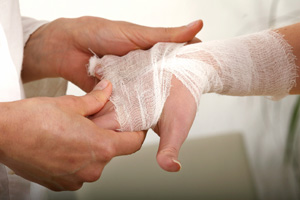Hand Surgery

Ganglion
Small and usually manifesting as a firm swelling or cyst, ganglions develop in tendon sheaths (the protective layer of tissue that covers tendons) or joint capsules (the protective covering of a joint). These benign, often painless swellings are filled with a thick, jelly-like fluid and are most commonly found under the skin on the wrist, at the end joint of a finger, or at the base of a finger. While ganglions typically disappear without treatment, options are available:
Aspiration drains fluid from the swelling using a needle and is performed under local anaesthetic to reduce discomfort, or steroids to reduce inflammation and the likelihood of the cyst refilling – although this commonly occurs.
Surgical removal addresses large painful ganglions that affect joint movement, cause neurological symptoms, or have refilled after aspiration. The cyst can be removed via a small incision either under general or local anaesthetic as a day procedure. Afterwards, a support dressing is applied for seven to ten days. Some discomfort, tenderness and swelling may occur. The incision heals quickly, leaving a small scar, and normal activities may resume in two to six weeks. Even with surgery, a ganglion may reoccur.
Carpel Tunnel
The median nerve, running from the forearm to the hand, is the source of Carpal Tunnel Syndrome. When pressed or squeezed at the wrist as a result of thickening from irritated tendons or other swellings which narrow the tunnel, pain, weakness, or numbness in the hand and wrist may result, radiating up the arm. Patients may experience pain at night which necessitates elevating the arm.
To treat this, surgeons make a small incision at the proximal part of the hand. Then, the bands of tissue which compress the nerve are cut back. Many patients require surgery on both hands, which may be done on the same day. The procedure is generally done under local anaesthesia on an outpatient basis, unless there are unusual medical considerations.
Dupuytren's Contracture
In this common hand deformity connective tissue under the skin of the palm contracts and toughens over time. Knots of tissue form under the skin, eventually forming a thick cord that can pull one or more fingers into a bent position. While affected fingers can bend, they will not completely straighten, making full use of the hand difficult.
Surgical treatment can slow the condition’s progression and relieve symptoms. Surgery should be carried out as soon as possible once the fingers are flexed. Untreated, stiffness may set in to the affected hand and the ultimate outcome may be compromised.
Although surgery can improve hand function, it will not necessarily prevent a recurrence of symptoms. As Dupuytren's may be a progressive disease, reoccurrence is a probability. Surgery is can be done under local or general anaesthetic as a day case procedure.
Congenital
This is a deformity of the hand at birth. It can be Polydactly (additional fingers) or another example is Syndactly (finger webbing).
Ulnar Nerve Decompression
The ulnar nerve gives sensation to the little and ring fingers and helps activate many of the muscles of the hand. When the nerve is compressed at the elbow a “pins and needles” feeling occurs in the little and ring fingers. Severe compression may cause numbness in these fingers and weakness in the hand. If splints fail to ease the symptoms surgical decompression may be carried out under a general anaesthetic as a day case procedure.
Trauma
Minor trauma, mainly skin lacerations, can be sutured under local anaesthesia as a day procedure. Other injuries such as a digital nerve or tendon laceration can usually be repaired under regional anaesthesia and can be carried out as a day procedure.
